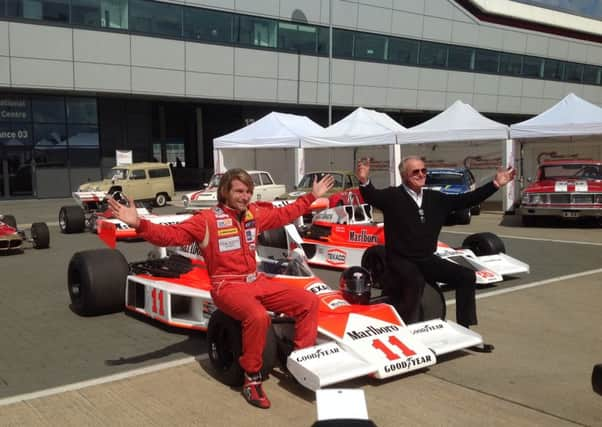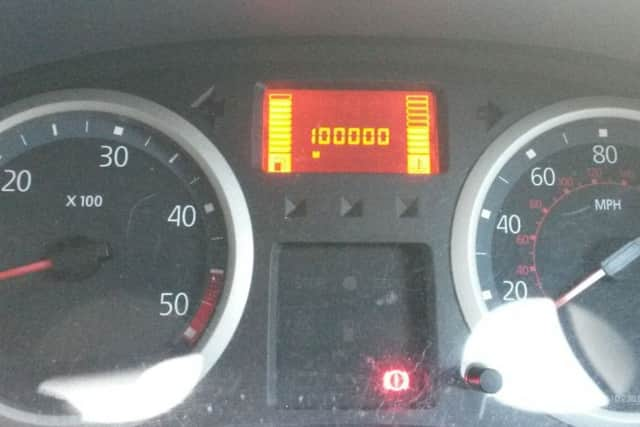Talking Motors: In pole position to glimpse Silverstone treats


I was fortunate enough to come within such close proximity to this heirloom of motorsport the other week while on a preview day of this summer’s Silverstone Classic at the Berkshire circuit.
Now in its 26th year, the Silverstone Classic is a ‘must attend’ for classic car fans.
Advertisement
Hide AdAdvertisement
Hide AdIt traditionally offers much more than a toot around rows of lovingly-polished classics in a field and this year is set to be no different.


What gets people excited about the Silverstone Classic is the action on the track, and I was lucky enough to be flung around the circuit at 150mph in a Porsche - even if my lap was over in a flash.
It started snowing half-way around, given summer is on the way, as my driver weaved us through Becketts.
And while I was hoping I’d packed clean clothes as the back end went round Stowe, the man with the wheel remained so calm I had to check he wasn’t tuning the radio.
Advertisement
Hide AdAdvertisement
Hide AdThe venue lends itself to a wealth of on-track action and at this year’s weekend, which takes place between July 29 and 31, there will be four separate touring car grids for the first time, FIA Masters Historic Formula One and the Stirling Moss Trophy to name just a few - as well as World GP bike legends.


But even with so much to get excited over, the biggest draw to this year’s festival for me, by far, will be the commemorations of Hunt’s World Championship year, 40 years on from the most dramatic finish to an F1 season ever.
I was fortunate enough to get a glimpse of what is happening at the festival when I walked into the paddock to be confronted by the McLaren M23 and its successor, the M26, which Hunt raced to victory at Silverstone in 1977.
Happily, they had also wheeled out the Hesketh 308, the car which Hunt first drove in F1 in 1974 - and it was wonderful to get up close and peer inside a car from an era when driver comfort was spared to save weight - there’s no driver’s seat and the heroes from the 70s were strapped onto the metal floor of the car - not a mode of transport for those with back problems!
Advertisement
Hide AdAdvertisement
Hide AdBut the highlight of the day was undoubtedly getting the chance to meet Freddie, James’s son, and talk about his memories of his dad after a racing career which saw him idolised by so many people.
Freddie confessed he isn’t much of a petrolhead, despite the fact he plies his trade as a driver in Euro Nascar and drives a Triumph GT6.
Though in an attempt to add weight to his claim, he does only drive a classic car as he couldn’t afford the insurance for a new car - I’ll leave it with you to work out why, let’s just say he is a chip off the old block in that sense!
And who was stood behind me as I queued for a helmet in order to be flung around the track? Alastair Caldwell, the McLaren team manager from 1974 to 1978.
Advertisement
Hide AdAdvertisement
Hide AdPlucking up the courage to initiate a chat, he falls very much into the petrolhead category, he was happy to spare a few minutes, and revealed the secret to Hunt’s success.
“After we were disqualified from our win at the British Grand Prix at Brands Hatch we thought we had no chance of winning the title,” he said.
“So I just let James do what he wanted.”
And anyone who knows about the antics off the track which made Hunt a tabloid star will know what Caldwell meant.
Mileage is a big issue when cars change hands.
The general consensus is that, moving other factors to one side, a second hand car with fewer miles on the clock will command an asking price of a few hundred, maybe a couple of thousand more than a car which has been round the block a few times.
Advertisement
Hide AdAdvertisement
Hide AdBut the issue people should be really thinking about is how well looked-after an engine is.
The issue was brought to light for me recent when a mate pulled over and took a triumphant photo of his Renault Clio showing a proud 100,000 on the clock. A coming of age if you will - the equivalent of a big birthday - a milestone but plenty more to come.
We had a Fiat Punto which we nursed to 133,000, which I’m told is a miracle for a Fiat, and it was still going.
Cosmetic surgery costing more than the car’s worth consigned it to the great scrap heap in the sky.
Advertisement
Hide AdAdvertisement
Hide AdI know some car owners, classic cars admittedly, who are desperately trying to keep the clock down on their cars, and I can’t help but wonder why.
Weren’t their cars made for the very purpose which is being denied of them?
My Midget is approaching 87,000 miles which may seem very low for a car approaching its 40th birthday, and I can’t wait to push it around the clock, eating up the last few miles with laps of a circuit of Billinge so I can pull over and take a snap when the clock reads 00000 again.
If owners don’t leave it too long between trips under the bonnet, replenish fluid levels and generally look after their cars, high mileage won’t be an issue.
The problem low-mileage classic owners face is what to do.
Advertisement
Hide AdAdvertisement
Hide AdLeaving a car stood is no good for it. It’s like spending months sat in bed doing nothing - your health suffers and joints go stiff - and the same happens to a car. They need running or stuff seizes up.
I saw a 1960s Mini at a show once with just 276 miles on it.
The paper mats were still in the footwells and the car smelled like BMC plastic - a smell few people will ever get to experience now.
There was even a packet of unopened L plates on the back parcel shelf.
Advertisement
Hide AdAdvertisement
Hide AdThe only reason I already knew what fresh 60s plastic smells like is because when I was a kid I opened up a load of toy cars at my grandad’s which had never been touched. I ruined their value but at least they eventually got played with.
So with an ultra low-mileage classic, owners face a dilemma, do they preserve their ‘as new’ status for future generations to have an insight into what these cars were like the day they were made - or do they grant the cars their purpose and drive them?